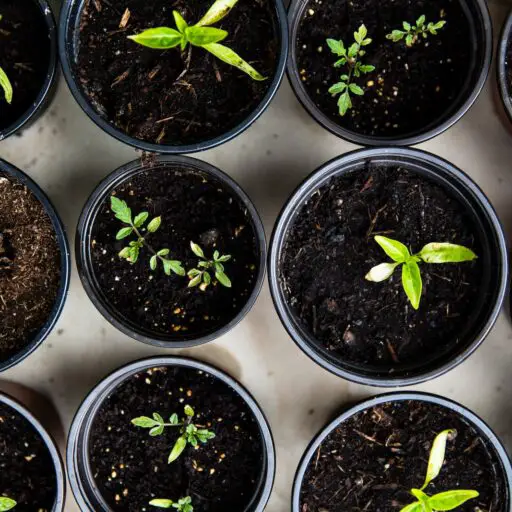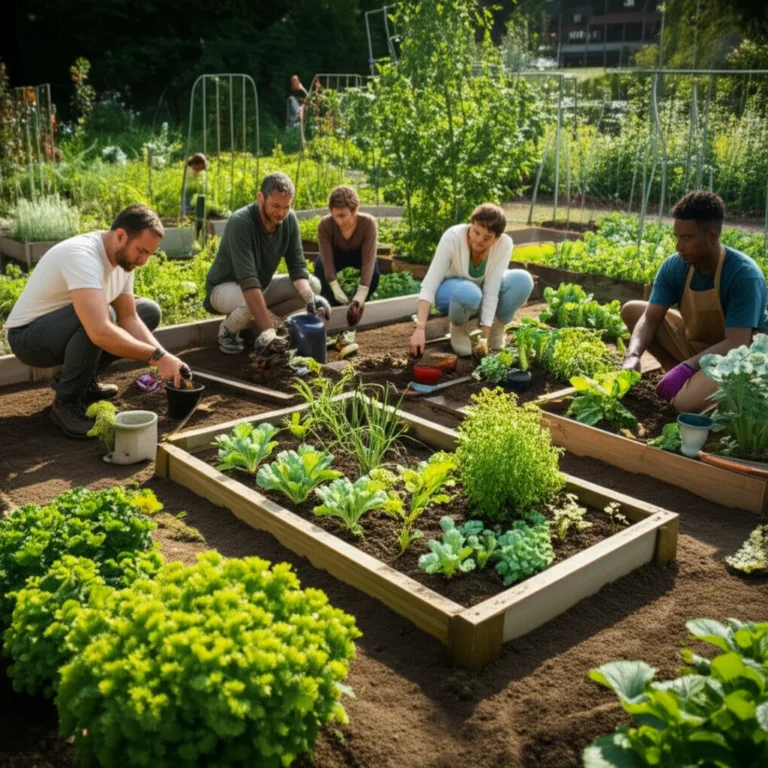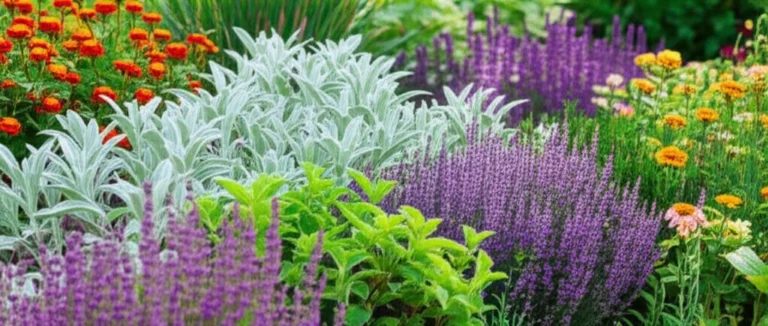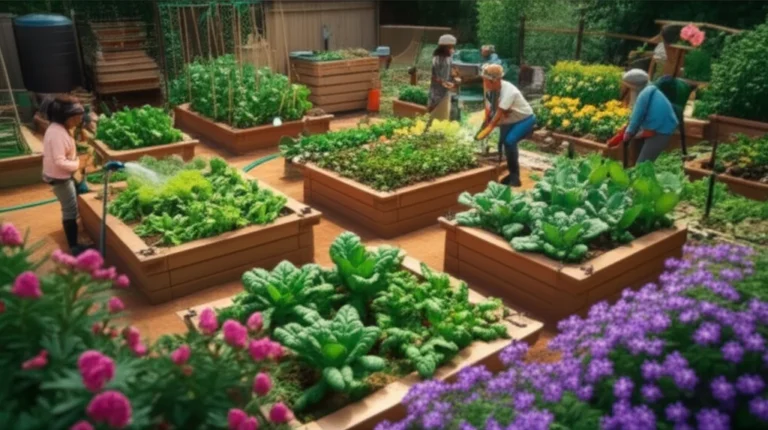Support our educational content for free when you purchase through links on our site. Learn more
Imagine turning a tiny urban lot into a lush, buzzing oasis where neighbors gather, fresh veggies flourish, and every inch of soil sings with life. Sounds like magic, right? Well, it’s not—it’s smart design! Whether you’re starting your first community garden or looking to boost an existing one, mastering space and productivity is the secret sauce to success.
In this article, we’ll reveal 12 expert tips from the gardeners at Community Gardening™ that transform cramped plots into bountiful, vibrant spaces. From choosing the perfect sunny spot to harnessing vertical gardening, companion planting, and cutting-edge tech, we cover everything you need to grow together and grow more. Plus, we’ll share inspiring success stories and practical tools to keep your garden thriving year-round. Ready to unlock your garden’s full potential? Let’s dig in!
Key Takeaways
- Choose a sunny, accessible location with rich, well-drained soil to set your garden up for success.
- Maximize space using vertical gardening and raised beds—perfect for urban plots with limited ground area.
- Use companion planting and crop rotation to boost yields and naturally deter pests.
- Implement efficient watering systems like drip irrigation and rainwater harvesting to conserve water.
- Prioritize soil health with composting and organic amendments for vibrant, productive plants.
- Design inclusive pathways and seating areas to welcome all community members.
- Engage your community through workshops, shared tasks, and clear signage to build ownership and pride.
- Leverage technology and garden management apps to streamline planning and communication.
👉 Shop recommended products to get started:
- Vertical Garden Planters | Raised Garden Beds | Drip Irrigation Kits | Rain Barrels | Organic Pest Control Kits
Explore Vertical Garden Planters on Amazon | Raised Beds on Walmart | Drip Irrigation Kits on Etsy
Table of Contents
- Quick Tips and Facts for Designing Productive Community Gardens 🌱
- The Roots of Community Gardens: History & Evolution of Urban Green Spaces 🌿
- 1. Choosing the Perfect Location: Sunlight, Soil, and Accessibility ☀️🛤️
- 2. Maximizing Space with Vertical Gardening and Raised Beds 🏗️🌼
- 3. Crop Selection and Companion Planting for High Yields 🌽🍅
- 4. Efficient Watering Systems: Drip Irrigation & Rainwater Harvesting 💧🌧️
- 5. Soil Health and Composting: The Secret Sauce for Productivity 🌱🪱
- 6. Pathways, Layouts, and Accessibility: Designing for Community Use 🚶♂️🛤️
- 7. Pest Management Without Chemicals: Natural and Organic Solutions 🐞🌸
- 8. Engaging the Community: Workshops, Signage, and Shared Responsibilities 🤝🌻
- Innovative Tools and Tech for Community Garden Design 🔧📱
- Seasonal Planning: Crop Rotation and Succession Planting for Year-Round Harvests 🍂🌞
- Sustainability Practices: Eco-Friendly Materials and Energy Efficiency 🌍♻️
- Success Stories: Inspiring Community Gardens That Nailed Space & Productivity 🏆🌿
- Conclusion: Growing Together for a Greener Tomorrow 🌱🤗
- Recommended Links for Community Garden Enthusiasts 🔗
- FAQ: Your Burning Questions About Community Garden Design Answered ❓🌻
- Reference Links and Further Reading 📚
Quick Tips and Facts for Designing Productive Community Gardens 🌱
Community gardens are a powerful force for good, bringing people together, fostering a sense of community, and providing access to fresh, healthy food. But designing a community garden that maximizes space and productivity takes careful planning and consideration.
Here are some quick tips and facts to get you started:
- Sunlight is key: Most vegetables and herbs need at least 6 hours of direct sunlight per day.
- Vertical gardening is your friend: Use trellises, walls, and other vertical structures to grow vining plants like tomatoes, beans, and cucumbers, maximizing space.
- Raised beds are a game-changer: They improve drainage, soil quality, and accessibility, especially for people with mobility issues.
- Companion planting is a win-win: Certain plants can help each other grow better, deter pests, and attract pollinators.
- Water wisely: Use drip irrigation systems to conserve water and deliver it directly to plant roots.
- Compost is your garden’s best friend: It improves soil fertility, reduces waste, and promotes healthy plant growth.
- Accessibility is crucial: Design pathways and seating areas that are accessible to everyone, regardless of their mobility.
- Engage the community: Host workshops, create signage, and encourage shared responsibilities to build a strong sense of ownership.
Did you know? Community gardens can help reduce food insecurity, promote environmental sustainability, and create a sense of connection within neighborhoods.
Let’s dive deeper into each of these aspects!
The Roots of Community Gardens: History & Evolution of Urban Green Spaces 🌿

Community gardens have a rich history, dating back centuries. They were often a necessity for families living in densely populated areas, providing a source of food and a connection to nature.
Here’s a brief timeline of community gardening’s evolution:
- Ancient Times: Community gardens were common in ancient civilizations like Rome and Egypt, where they served as a vital source of food for urban populations.
- Medieval Europe: Monasteries and convents often maintained gardens for their communities, providing food and medicinal herbs.
- 19th Century: The Industrial Revolution led to the growth of cities and the displacement of many people from rural areas. This spurred the development of community gardens as a way to provide food and green space in urban environments.
- 20th Century: Community gardens gained popularity in the United States during the Great Depression and World War II, as a way to supplement food supplies and promote self-sufficiency.
- 21st Century: Today, community gardens are increasingly recognized for their social, environmental, and health benefits. They are a powerful tool for promoting food security, environmental sustainability, and community building.
The evolution of community gardens has been driven by a variety of factors, including:
- Urbanization: The growth of cities has led to a need for green spaces and food sources in urban areas.
- Food Security: Community gardens provide access to fresh, healthy food for people who may not have access to traditional grocery stores or farmers markets.
- Environmental Sustainability: Community gardens promote sustainable practices, such as composting, water conservation, and biodiversity.
- Social Cohesion: Community gardens bring people together, fostering a sense of community and shared purpose.
Community gardens are more than just a place to grow food; they are a powerful symbol of hope, resilience, and community.
1. Choosing the Perfect Location: Sunlight, Soil, and Accessibility ☀️🛤️
Finding the right location is crucial for a successful community garden. It’s like finding the perfect spot for your home – you want it to be sunny, well-drained, and easy to access.
Here are some key factors to consider:
1.1 Sunlight
- Sunlight is essential for plant growth. Most vegetables and herbs need at least 6 hours of direct sunlight per day.
- Look for a location that receives plenty of sunlight throughout the day. Avoid areas that are shaded by trees or buildings.
- Consider the direction of the sun. In the Northern Hemisphere, south-facing locations receive the most sunlight.
1.2 Soil
- Good soil is the foundation of a healthy garden. Test the soil to determine its pH, nutrient content, and drainage.
- Ideally, you want soil that is well-drained and rich in organic matter. This will help your plants thrive.
- If the soil is poor, you can amend it with compost, manure, or other organic materials.
1.3 Accessibility
- Choose a location that is easily accessible to everyone in the community. This includes people with disabilities, seniors, and families with young children.
- Consider the proximity to parking, public transportation, and restrooms.
- Ensure that the pathways are wide enough for wheelchairs and strollers.
Think about the community you’re serving and how the garden can be inclusive and welcoming to everyone.
2. Maximizing Space with Vertical Gardening and Raised Beds 🏗️🌼
Community gardens often face space constraints, but there are creative ways to maximize your growing area.
Here are two popular techniques:
2.1 Vertical Gardening
- Vertical gardening is a great way to grow plants in limited space. It involves growing plants upwards, using trellises, walls, or other vertical structures.
- Vining plants like tomatoes, beans, cucumbers, and melons are ideal for vertical gardening.
- There are many different types of vertical gardening systems available, from simple trellises to more elaborate structures.
👉 CHECK PRICE on:
Vertical gardening can be a beautiful and productive way to add greenery to your community garden.
2.2 Raised Beds
- Raised beds are another great way to maximize space and improve soil quality. They are raised above ground level, allowing for better drainage and easier access.
- Raised beds can be made from a variety of materials, including wood, stone, and metal.
- They are especially helpful in areas with poor soil or drainage.
👉 CHECK PRICE on:
Raised beds can be a great way to create a more accessible and productive garden.
Think about the needs of your community and choose the space-saving techniques that will work best for your garden.
3. Crop Selection and Companion Planting for High Yields 🌽🍅
Choosing the right crops is essential for a productive community garden. You want to select plants that are well-suited to your climate, soil, and the needs of your community.
Here are some tips for selecting crops:
- Consider the growing season: Choose crops that will thrive in your local climate and have a long growing season.
- Think about the needs of your community: What kind of produce do people want? Are there any dietary restrictions or preferences?
- Choose a variety of crops: This will ensure a diverse harvest and provide a range of nutrients.
- Start with easy-to-grow crops: This will help build confidence and success.
Companion planting is a great way to boost productivity and deter pests.
Here are some common companion planting combinations:
| Plant 1 | Plant 2 | Benefits |
|---|---|---|
| Tomatoes | Basil | Basil repels tomato hornworms and improves tomato flavor. |
| Carrots | Onions | Onions deter carrot root flies and improve carrot growth. |
| Lettuce | Radishes | Radishes deter cabbage white butterflies and improve lettuce growth. |
Companion planting can be a fun and effective way to create a more harmonious and productive garden.
4. Efficient Watering Systems: Drip Irrigation & Rainwater Harvesting 💧🌧️
Water is essential for plant growth, but it’s also a precious resource.
Here are two ways to water your community garden efficiently:
4.1 Drip Irrigation
- Drip irrigation systems deliver water directly to plant roots, minimizing waste and evaporation.
- They are a great way to conserve water and reduce labor costs.
- Drip irrigation systems can be customized to meet the specific needs of different plants.
👉 CHECK PRICE on:
4.2 Rainwater Harvesting
- Rainwater harvesting is a sustainable way to collect and reuse rainwater.
- It can be used to water your garden, reducing your reliance on municipal water supplies.
- There are many different types of rainwater harvesting systems available, from simple rain barrels to more elaborate systems.
👉 CHECK PRICE on:
By using efficient watering systems, you can conserve water and create a more sustainable garden.
5. Soil Health and Composting: The Secret Sauce for Productivity 🌱🪱
Healthy soil is the foundation of a productive garden.
Here are some tips for improving soil health:
- Add organic matter: Compost, manure, and other organic materials improve soil structure, drainage, and nutrient content.
- Test your soil: This will help you determine the pH, nutrient content, and other factors that affect plant growth.
- Use cover crops: Cover crops help to improve soil health by adding organic matter, preventing erosion, and suppressing weeds.
- Avoid using chemical fertilizers and pesticides: These can harm soil microbes and beneficial insects.
Composting is a great way to recycle organic waste and create nutrient-rich soil amendment.
Here are some tips for composting:
- Choose a composting method that works for you. There are many different types of compost bins available, from simple tumblers to more elaborate systems.
- Add a mix of green and brown materials. Green materials, such as kitchen scraps and grass clippings, provide nitrogen. Brown materials, such as leaves and twigs, provide carbon.
- Keep your compost moist and aerated. This will help the decomposition process.
- Turn your compost regularly. This will help to aerate the pile and speed up decomposition.
By improving soil health and composting, you can create a garden that is both productive and sustainable.
6. Pathways, Layouts, and Accessibility: Designing for Community Use 🚶♂️🛤️
A well-designed community garden is welcoming and accessible to everyone.
Here are some tips for creating a user-friendly layout:
- Pathways: Create clear and wide pathways that are easy to navigate, especially for people with mobility issues.
- Seating areas: Provide seating areas where people can relax and enjoy the garden.
- Accessibility features: Consider adding ramps, handrails, and other accessibility features to make the garden accessible to everyone.
- Signage: Use clear and concise signage to identify different areas of the garden, such as planting beds, tool sheds, and composting areas.
- Lighting: Provide adequate lighting for evening use.
Think about the needs of your community and design a garden that is inclusive and welcoming to everyone.
7. Pest Management Without Chemicals: Natural and Organic Solutions 🐞🌸
Protecting your garden from pests is essential for a successful harvest.
Here are some natural and organic pest management techniques:
- Attracting beneficial insects: Beneficial insects, such as ladybugs, lacewings, and parasitic wasps, can help control pest populations.
- Using companion plants: Certain plants can repel pests or attract beneficial insects.
- Handpicking pests: This is a simple and effective way to control small infestations.
- Using traps: Traps can help to catch and remove pests.
- Applying organic pesticides: Organic pesticides are derived from natural sources and are less harmful to the environment than synthetic pesticides.
👉 CHECK PRICE on:
By using natural and organic pest management techniques, you can protect your garden and the environment.
8. Engaging the Community: Workshops, Signage, and Shared Responsibilities 🤝🌻
A thriving community garden is built on strong community engagement.
Here are some ways to engage your community:
- Host workshops: Offer workshops on gardening basics, composting, pest management, and other topics.
- Create signage: Use clear and concise signage to identify different areas of the garden, provide instructions, and share information.
- Encourage shared responsibilities: Assign tasks to different groups or individuals, such as watering, weeding, and harvesting.
- Organize social events: Host potlucks, garden tours, and other events to bring people together.
By engaging your community, you can create a sense of ownership and pride in your garden.
Innovative Tools and Tech for Community Garden Design 🔧📱
Technology can be a powerful tool for community garden design and management.
Here are some innovative tools and tech that can help:
- Garden planning apps: Apps like Garden Planner and GrowVeg can help you design your garden layout, track your crops, and manage your tasks.
- Smart irrigation systems: Smart irrigation systems use sensors to monitor soil moisture and adjust watering schedules, conserving water and ensuring optimal plant growth.
- Community garden management software: Software like GardenShare and Community Garden Manager can help you manage plot assignments, track volunteer hours, and communicate with gardeners.
👉 CHECK PRICE on:
- Garden Planner App: Apple App Store | Google Play Store
- GrowVeg App: Apple App Store | Google Play Store
- GardenShare Software: GardenShare Website
- Community Garden Manager Software: Community Garden Manager Website
By embracing technology, you can create a more efficient, sustainable, and engaging community garden.
Seasonal Planning: Crop Rotation and Succession Planting for Year-Round Harvests 🍂🌞
A well-planned community garden can provide a continuous harvest throughout the year.
Here are two key techniques for seasonal planning:
5.1 Crop Rotation
- Crop rotation is the practice of planting different crops in the same area each year. This helps to prevent the buildup of pests and diseases and improve soil fertility.
- For example, you might plant tomatoes one year, beans the next year, and carrots the following year.
- Crop rotation can also help to improve soil structure and nutrient content.
5.2 Succession Planting
- Succession planting is the practice of planting new crops as soon as the previous crops are harvested. This helps to keep your garden productive throughout the growing season.
- For example, you might plant lettuce in early spring, followed by beans in late spring, and then tomatoes in summer.
- Succession planting can also help to extend your harvest season.
By using crop rotation and succession planting, you can create a garden that is productive throughout the year.
Sustainability Practices: Eco-Friendly Materials and Energy Efficiency 🌍♻️
Community gardens have a unique opportunity to promote sustainability.
Here are some ways to make your garden more eco-friendly:
- Use recycled materials: Use recycled materials, such as pallets, tires, and plastic containers, to create raised beds, trellises, and other garden structures.
- Conserve water: Use drip irrigation systems, rainwater harvesting, and other water-saving techniques.
- Reduce waste: Compost food scraps and yard waste, and use organic pest control methods.
- Use renewable energy: Consider using solar panels to power your garden tools and equipment.
By embracing sustainable practices, you can create a garden that is both productive and environmentally friendly.
Success Stories: Inspiring Community Gardens That Nailed Space & Productivity 🏆🌿
There are countless inspiring examples of community gardens that have successfully maximized space and productivity.
Here are a few examples:
- The Edible Schoolyard Project: This project, founded by chef Alice Waters, has transformed schoolyards into edible gardens, teaching students about food, nutrition, and sustainability.
- The Poughkeepsie Farm Project: This project has created a network of community gardens in Poughkeepsie, New York, providing fresh food and green space to residents.
- The Detroit Black Community Food Security Network: This network has created a network of community gardens in Detroit, Michigan, providing food and economic opportunities to residents.
These are just a few examples of the many community gardens that are making a difference in their communities.
Let’s learn from these success stories and create our own thriving community gardens!
Conclusion: Growing Together for a Greener Tomorrow 🌱🤗

Designing a community garden that maximizes space and productivity is both an art and a science — a beautiful dance between nature, community, and creativity. From choosing the perfect sunny spot to embracing vertical gardening and raised beds, every decision shapes the garden’s success. Remember, healthy soil and smart watering systems are your garden’s lifeblood, while engaging the community ensures the garden thrives long after the first seed is planted.
We’ve explored how companion planting can boost yields, how natural pest management protects your crops without harming the environment, and how technology can streamline garden management. Plus, seasonal planning and sustainability practices help your garden flourish year-round while respecting Mother Earth.
If you’re feeling overwhelmed, take a deep breath and start small — constraint is the secret to success! Whether you’re a seasoned green thumb or a first-time gardener, the key is to grow together, learn from each other, and celebrate every harvest.
So, are you ready to roll up your sleeves and turn that patch of land into a vibrant, productive oasis? We’re cheering you on every step of the way! 🌻
Recommended Links for Community Garden Enthusiasts 🔗
👉 Shop Vertical Gardening & Raised Bed Supplies:
- Vertical Garden Planters: Amazon | Walmart | Etsy
- Wall Trellises: Amazon | Walmart | Etsy
- Raised Garden Beds: Amazon | Walmart | Etsy
Efficient Watering Solutions:
Organic Pest Control & Beneficial Insects:
Garden Planning & Management Tools:
- Garden Planner App: Apple App Store | Google Play Store
- GrowVeg App: Apple App Store | Google Play Store
- GardenShare Software: GardenShare Official Website
- Community Garden Manager Software: Community Garden Manager Official Website
Recommended Books:
- The Community Garden Handbook by Ben Raskin — A practical guide full of design ideas and community engagement tips.
- Square Foot Gardening by Mel Bartholomew — The classic on maximizing garden space efficiently.
- Teaming with Microbes by Jeff Lowenfels & Wayne Lewis — Dive deep into soil health and composting secrets.
FAQ: Your Burning Questions About Community Garden Design Answered ❓🌻

How can I plan a community garden layout to ensure optimal sunlight and water distribution for all plots?
Planning for sunlight and water is like choreographing a dance where every plant gets its spotlight and hydration. Start by mapping your garden area and observing sun patterns throughout the day. Most vegetables need 6+ hours of direct sun, so position taller plants on the north side (in Northern Hemisphere) to avoid shading shorter ones. Incorporate drip irrigation or soaker hoses laid out in zones to deliver water efficiently, ensuring each plot receives adequate moisture without waste. Consider installing rain barrels to supplement watering sustainably. Remember, good layout planning reduces competition and boosts productivity!
What are some space-saving strategies for community gardens, such as vertical gardening or container gardening?
When space is tight, think up — literally! Vertical gardening using trellises, cages, and wall-mounted planters lets you grow vining crops like cucumbers, beans, and tomatoes without hogging ground space. Container gardening is perfect for patios or uneven terrain, allowing you to move plants as needed and control soil quality. Raised beds packed with companion plants and intercropping also maximize every inch. Don’t forget succession planting to keep beds productive all season long. These strategies turn small plots into bountiful harvests!
What types of plants are best suited for community gardens with limited space, and how can they be arranged for maximum productivity?
Choose plants that thrive in close quarters and complement each other. Leafy greens (lettuce, spinach), herbs (basil, parsley), root veggies (radishes, carrots), and compact fruiting plants (cherry tomatoes, peppers) are excellent choices. Use companion planting to pair crops that deter pests or enhance growth — like tomatoes with basil or carrots with onions. Arrange taller plants to the north or back of beds, with shorter plants in front to optimize sunlight. Interplant fast-growing crops with slower ones to maximize yield. Remember, diversity is your garden’s secret weapon!
How can community gardeners work together to maintain and manage the garden, including tasks such as composting, pruning, and pest control?
A community garden thrives on teamwork and shared responsibility. Establish clear roles and schedules for watering, weeding, pruning, and harvesting. Set up a composting system where everyone contributes kitchen scraps and garden waste, turning it into black gold for soil health. Hold regular meetings or workshops to educate gardeners on organic pest control methods and best practices. Use signage and communication tools (like a shared calendar or app) to coordinate tasks and celebrate successes. When everyone pitches in, the garden becomes a vibrant hub of learning and growth!
How do I ensure soil safety and fertility in an urban community garden setting?
Urban soils can sometimes harbor contaminants like heavy metals. It’s essential to test your soil through local extension services or labs before planting edible crops. If contaminants are present, use raised beds with clean, imported soil or container gardening to keep produce safe. Regularly amend soil with compost and organic matter to boost fertility and promote healthy microbial life. Avoid using chemical fertilizers or pesticides that can harm soil health. Healthy soil = healthy plants = healthy community!
Reference Links and Further Reading 📚
- Community Garden Toolkit – North Carolina State University — Comprehensive guide on community garden setup and management.
- Planning Your Garden (for beginners) — Three Acre Farm — Fantastic resource on garden planning basics and layout.
- SeedMoney Blog: How to Make Your Garden a Worm Paradise — Insights on soil health and composting with worms.
- Productive Parks: Developing and Maintaining Community Gardens — Tips on community garden benefits and management.
- Garden Planner Official Site — Tool for designing garden layouts.
- GrowVeg Official Site — Garden planning and management software.
- GardenShare Official Website — Community garden management platform.
- Community Garden Manager Official Website — Software for garden administration and communication.
Ready to dig in? For more inspiration and practical advice, check out our Garden Design Ideas and Benefits of Community Gardens articles. Happy gardening! 🌻🌿





